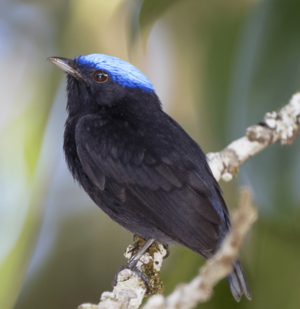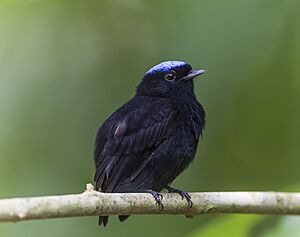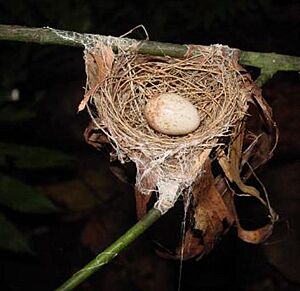Blue-capped manakin facts for kids
Quick facts for kids Blue-capped manakin |
|
|---|---|
 |
|
| Adult male photographed in Manacapuru, Brazil | |
| Conservation status | |
| Scientific classification | |
| Genus: |
Lepidothrix
|
| Species: |
coronata
|
 |
|
| Synonyms | |
|
Pipra coronata Spix, 1825 |
|
The blue-capped manakin (Lepidothrix coronata) is a small, colorful bird found in the forests of South America. These birds are part of the Pipridae family, known for their bright colors and interesting courtship displays.
Male blue-capped manakins are easy to spot because they have a super bright blue cap on their heads. Their bodies can be either black or green, depending on where they live. They are found in countries like Bolivia, Brazil, Colombia, Ecuador, Peru, and Venezuela. They prefer to live in wet lowland forests or even in forests that have been changed by people.
Contents
About the Blue-capped Manakin
Naming the Bird
The blue-capped manakin was first officially described in 1825 by a German scientist named Johann Baptist von Spix. He gave it the scientific name Pipra coronata. The word coronata comes from Latin and means "crowned," which makes sense because of the bird's blue cap! Later, in 1854, a French scientist named Charles Lucien Bonaparte placed it in a new group, or genus, called Lepidothrix.
Different Kinds of Blue-capped Manakins
Scientists have identified six different types, or subspecies, of the blue-capped manakin. These types were mainly named based on how the male birds look, especially their plumage (feathers). For example, some males are completely black, while others are mostly green, like the females.
However, recent studies looking at the birds' DNA show that these groups might not be as clear-cut as their looks suggest. Birds that look very different can actually be closely related genetically.
In 2022, a group of bird experts decided to make some changes. They found that some blue-capped manakins were so different in their calls and DNA that they should be considered a separate species. This new species is now called the velvety manakin. This means the original "blue-crowned manakin" was renamed the "blue-capped manakin" to avoid confusion.
How They Evolved
The different groups of blue-capped manakins have changed over time based on where they live. Big natural barriers like the Amazon River and the Andes Mountains have played a huge role in separating these bird populations. For example, the Amazon River acts like a giant wall, keeping birds on one side separate from birds on the other.
Even though these birds can fly, they prefer to stay in the lower parts of the forest that don't flood. So, large rivers become a real obstacle for them. Sometimes, groups of birds that aren't separated by a physical barrier might have still evolved differently because they were apart for a long time.
What They Look Like
Blue-capped manakins show sexual dimorphism, which means males and females look different. They also have different weights and wing lengths.
Females are a bit heavier, weighing about 9.8 grams on average. Males are lighter, usually around 8.5 grams. Males also have slightly longer wings, averaging about 60.45 millimeters, while females' wings are about 58.76 millimeters long.
Adult males are mostly a sooty black color with that striking bright blue cap. Females, on the other hand, are mostly green. Young birds look similar to females but have duller colors.
These birds go through a process called molting, where they shed their old feathers and grow new ones. Young males slowly gain their adult male colors over about three years.
What They Sound Like
Blue-capped manakins have different calls for different reasons. Their main "contact call" sounds like a swee. Both young and old birds use this call. Males use it when they are on their favorite perching spots or when they are interacting with other manakins. Females and young birds use a softer swee sound when they are looking for food.
Territorial males also have a special "advertisement call" that sounds like chi-wrr. This call helps them mark their territory and attract mates. They also make a preew call when they are interacting with other birds in their area. During their special displays, males make a pee call, which can be repeated many times.
Where They Live
Blue-capped manakins live in the lower parts of the non-flooded forests in South America. They prefer the understory, which is the layer of vegetation below the main tree canopy.
How They Live
Family Life
The breeding season for blue-capped manakins happens during the dry season, from late November to early April. Male manakins are known to perform special courtship displays to attract females. Sometimes, a single male will display alone, but other times, several males will gather in a special area called a lek to display together.
Males, even young ones, will claim and defend their own areas, or territory. They use their songs to defend their territory and attract mates. They sing from special "song perches," which are usually horizontal branches. Their display courts, where they perform their dances, are open areas on the forest floor, about 3 to 5 meters wide.
Female blue-capped manakins build simple, cup-shaped nests using dry leaves, bark, and palm fibers. They use spider webs to help attach their nests securely to small shrubs or tree branches, usually less than 1 meter off the ground. They often choose plants like Rudgea species for their nests.
Only the female builds the nest and takes care of the young. They usually lay two eggs at a time. Sadly, many nests are lost to predation (when other animals eat the eggs or young birds). To help protect their nests, blue-capped manakins try to build them away from other bird species that like similar nesting spots. This helps spread out the nests and makes it harder for predators to find them all.
What They Eat
Blue-capped manakins are mainly frugivores, which means they love to eat fruit! Their diet includes fruits from various plants like Melastomataceae, Moraceae, Bromeliaceae, and Araceae.
Sometimes, blue-capped manakins will join mixed flocks with other bird species, like antshrikes and antwrens. When they are in these flocks, they usually look for arthropods, such as ants, flies, and other small insects. They catch these insects by quickly darting out from a perch to grab them from leaves. It's thought that they join these flocks because the other birds stir up insects, making them easier to catch. Even though they are mostly fruit-eaters, they take advantage of these opportunities to get some extra protein.
Challenges They Face
Blue-capped manakins face a big challenge: many of their nests are eaten by predators. About 70% of their nests fail because of this, and only a small number of young birds successfully leave the nest. Scientists are not sure how these birds keep their populations stable with such low success rates, but they think it might be because females live a long time and try to breed multiple times each season.
These birds can also get sick from tiny parasites that live in their blood. Studies have shown that about half of the manakins tested had these blood parasites. Young birds seem to get infected more often than adults.
Their Conservation Status
The blue-capped manakin is currently listed as a species of "least concern" for conservation. This is mainly because they live across a very large area, covering about 5,050,000 square kilometers. While their exact population size isn't known, it is thought to be decreasing.





